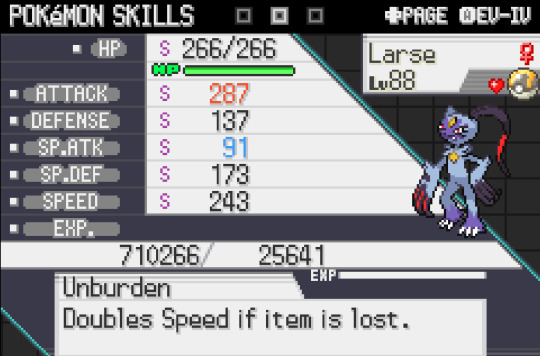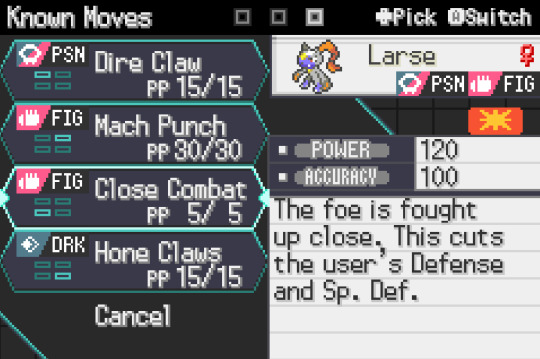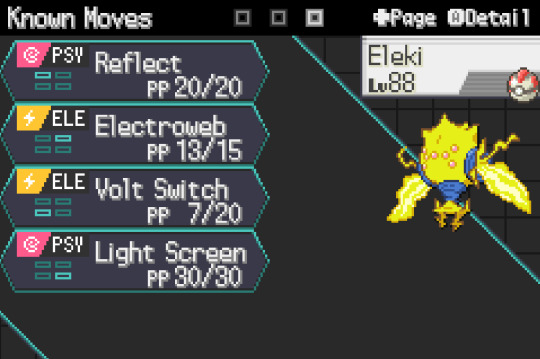#but to be fair the miss chance in the trailer is such a dealbreaker for me it isn't even funny
Explore tagged Tumblr posts
Text
Using What in "Hell" is Bad as an excuse to talk about video game mechanics (pt. 1)
And honestly, not just as an excuse - but also as a way to voice out my concerns for the gameplay.
Because I've been thinking about the game mechanics in What in "Hell" is Bad, specifically the damage instance miss as shown in the gameplay trailer of WHB and how it's something that I personally am not a fan of (as the bitch who cares more about the gameplay than anything else), and I think it all boils down to game design. There's several points to it that I hope I can get through eloquently, but it all does boil down to one key issue:
Consistency.
Now, what do I mean by that?
(more under the cut!)
Also, a disclaimer: ALL of the situations below are based on my thought processes, as someone who likes a challenge in gaming. I play Nuzlockes, I like mainline SMT, I do high Surging in IS3 (currently attempting 11), I play hard Pokémon romhacks, and more. Not everyone will think like I do, and that's fine.
And even though the opening statement is for WHB, at the end of the day I end up talking extensively about my thought processes in building a team for hard Pokémon romhacks, specifically Radical Red, so. Just a heads-up!
Consistency, in this case, is basically a measure of how often a skill/strategy is able to have an effect. The less RNG is required for a skill/strategy to work, the more consistent it is. It's the usual Fire Blast vs Flamethrower debate - would you risk the 85% accuracy for a 120 (gen 1-5)/110 (gen 6 onward) base power attack in Fire Blast, or take the guaranteed hit with a lower base power of 95 (gen 1-5)/90 (gen 6 onward) in Flamethrower? Some would take the Fire Blast, others would prefer the Flamethrower.
Consistency issues usually don't tend to be a thing in most tower defense games, in my experience. Most if not all damage instances are sure hits (unless the enemy has some sort of immunity), and RNG factors are minimal when it comes to inflicting damage. That isn't to say RNG is completely gone from tower defense games - the easiest examples being the butter from Kernelpults in Plants vs Zombies and certain Operator Talents like Mountain's 15% physical dodge or Lin's 50% chance of SP recovery on hit in Arknights. These RNG factors are balanced in a sense that they either have a decent chance for a completely broken effect (butter stopping a zombie completely for several seconds), are ultimately nice bonuses for an already strong base kit (how I feel the dodge on Mountain's Talent is), or works well in accordance to their archetype (how I feel Lin's Talent is, which is boosted heavily and turns her into a stellar unit with her Module, increasing the SP regen chance from 50% to a more consistent 75%).
As a result, having an attack from a ranged unit miss in WHB's trailer, while understandable due to attacking from a distance, is another source of RNG - and while it may be a breath of fresh air in tower defense, as a mechanic I can see it inciting rage. In what way, however?
For me, it's easiest to explain in a Pokémon setting. As a side note, all the screenshots used are from the Radical Red romhack, a romhack of FireRed that has all Pokémon and moves introduced in Generation 9 while including all of the updated game mechanics (minus Terastalization) and being a generally hard game - even with both minimal grinding and Easy mode on.
(OP is trying to catch and evolve all possible Pokémon while leaving all the mind-bending team building in Run & Bun, so she chose those settings)

This is Regieleki's moveset upon capture within the Power Plant Raid Den in Radical Red. Zap Cannon is a supremely strong move that guarantees Paralysis on the opposing Pokémon if it hits, but it only hits 50% of the time. Yet in most situations, you never see this thing run Zap Cannon - despite its side effect and damage. You want to know why?

Its ability, Transistor.
Transistor plus the same type attack bonus (STAB) makes Regieleki deal absolutely ludicrous amounts of damage with its Electric type attacks. A weaker but more accurate Thunderbolt (95/90 base power depending on the generation with a chance to paralyze, but has 100 accuracy) is more than enough for damage because of its damage multipliers, without the chance of it missing. Of course, you could always use a move like Lock On or other ways to boost your Zap Cannon's accuracy, but you're putting yourself in danger because you'll be wasting a turn you can use to potentially pick up a KO while leaving it susceptible to getting KO'd itself.
So, it all comes down to risk vs reward: do you take the risk of a miss/KO to deal insane amounts of damage AND a status effect, or do you take the weaker guaranteed hit that might not inflict the status effect?
Back to WHB - it would seem like ranged units are the ones with a chance to miss, while the melee units all have guaranteed hits. And judging from the footage, it would seem that Paimon is the unit that did most if not all of the missed attacks, which leads me to hypothesize:
The miss might be due to Paimon's passive skill.
Miss chance might be based on unit rarity - because I don't recall seeing Gabriel and Satan miss anything, and they both are of higher rarity than Paimon.
The miss chance is necessary to balance the subclass Paimon is part of.
On paper, this sounds fine - a fresh way to implement a risk vs reward mechanic in team-building, encouraging varied team compositions to maximize damage. However, there's a reason why I placed emphasis on the fact it's on paper, because the implementations as seen in the preview itself is...less than ideal.
See, when someone thinks of risk vs reward, the risk you're taking must be directly proportional to the perceived reward for it to be a viable choice for the player. Otherwise, what is intended to be a high-risk-high-reward move that has some viability will be perceived as high-risk-mediocre-reward without any viability. In other words, if the reward obtained is not worth the risk taken, then the player most likely won't take the risk, and you're not doing this entire "risk vs reward" thing right.
As an example, let's take a look at Unburden Sneasler in Radical Red, in the context of building a team to go against Lorelei of the Elite Four.


Unburden Sneasler by principle is a relatively frail physical sweeper. With Unburden it becomes one of the fastest Pokemon in the entire game provided it loses its held item as its already high base speed is doubled with Unburden. There are several ways it can lose a held item - consuming a one-time use item (so stuff like Berries, Focus Sash, Herbs, and Gems) or using Fling.
So, the question becomes this:
Would you take the chance of Sneasler taking huge damage and/or dying on turn one to be able to strike first and deal immense damage on the enemy in the following turns?
Because Sneasler, despite its weaker defensive stats, has a typing that gives it 6 resistances with only 3 weaknesses (with only one of them being a quad weakness - Psychic). And you're definitely looking for ways to lose your item ASAP to activate Unburden. If you can, for example, knock out Lorelei's Alolan Ninetales on her Hail team before it can set up Aurora Veil (increases the party's defensive stats for 8 turns, as it's holding the Light Clay, increasing the length of these buffs), then you're in a much better position for the rest of the fight, right?
For context, let's theorycraft and look at these Pokémon in a vacuum for a bit. Lorelei's Hail team leads with Alolan Ninetales and Glaceon. Ninetales starts up Hail with its ability Snow Warning, allowing it to use Aurora Veil (which only works in Hail). Her Glaceon has Slush Rush, doubling its Speed in Hail - and outspeeding Sneasler. Sneasler will still outspeed Ninetales, but the Glaceon will likely aim to Earth Power the Sneasler, seeing as it'll deal more damage - especially with the Choice Specs (increases special attack by 50% but locks the Pokemon into the first move it used).
If Sneasler is holding the Shuca Berry (reduces the first Ground damage instance by 50%), there's a chance it's going to survive, while Unburden is activated. You take out the Ninetales turn one with both of your Pokemon (this means you'll also need a Pokemon faster than Ninetales as your other lead), and you can then Close Combat the next turn to deal immense damage and hopefully pick up another KO with your speedy Sneasler. Hell, if the Calyrex-Ice comes in, you might want to double into that slot to get rid of it before it can start stacking boosts!
However, there is still a source of inconsistency in the form of a critical hit. Critical hits deal 50% more damage and happens at a 1/24 chance (starting generation 7). Assuming Shuca Berry with a critical? Even the Sneasler might not be strong enough to tank the Earth Power, with both the Choice Specs boost and Glaceon's high base Special Attack.
But back again to WHB. So, what about this risk vs reward concept in terms of Paimon? Well, based on what we're seeing in the trailer, I don't think the risk of his attacks missing is worth the reward of his utility.
Several things to note. First of all, his regular attacks don't seem to inflict any sort of ailment. His slow seems to be only on skill proc, and unless my eyes deceived me then the damage instance on the skill also missed. Thankfully, the slow is still inflicted on the opponent, but...man. Too many of Paimon's attacks missed (misses were a majority!) - and those that hit aren't even as strong as other units like Eligos (192 damage/hit) and Satan (166 damage/hit). The Pokémon equivalent of this is having Hustle (increases Attack by 50% for a 20% drop in accuracy for Physical attacks), but even then Paimon's accuracy is arguably much worse.
Why would you use Paimon if you have much more consistent DPS options, and if you don't find his slow particularly useful or impactful? As far as DPS goes, he's outpaced by everyone else, at 115 damage/hit. A slot that you could've used for another, more impactful unit, is used on a unit that doesn't seem to be bringing that much value into the team.
Perhaps there may be fringe cases where his kit is useful. Or there's a chance his current level as shown on the trailer presents him not at his full potential. Maybe down the line Paimon's archetype might be more usable as the game evolves, too! But as we see him right now, he isn't quite worth the opportunity cost of having another, more impactful unit on the squad, assuming you have alternatives.
Actually, let's talk about opportunity cost. It's a concept that talks about what opportunities are lost when not taking a specific option. Any character, any build, any strategy - basically anything I don't use represents an opportunity cost.
As an example, let's take a look at my current Regieleki build.

With Regieleki's stat spread and moveset, there are several main "modes" this Pokémon can run. It can utilize its speed for a full support build, with the ability to set up Reflect (increases party Defense for 5 turns) and Light Screen (increases party Special Defense for 5 turns) before its opponents while still having a speed control option with Electroweb (hits both enemies in a double battle, weak damage while dropping enemy speed). It can also utilize its Transistor ability to function as a speedy special sweeper, running stronger Electric moves like Thunderbolt (base power 95 with 100 accuracy) or Thunder (base power 110 with 85 accuracy, 100 accuracy in rain). The held items and specific stat builds will differ depending on the mode - support Regieleki would run an HP boosting nature to help with its bulk somewhat, while the special sweeper build would run a Special Attack boosting nature, for example.
Both builds are good, but we're playing a hard romhack here. Realistically I can only bring one Regieleki, because having more than one means I'll be gimping my team in terms of type coverage and resistances. And even then there are other support units that might be worth looking into - an example being the standard Grimmsnarl support build with the Prankster ability (status moves gain +1 priority, helping them proc first, but doesn't affect Dark type Pokémon) and the aforementioned Light Clay, running Reflect and Light Screen (both moves increasing the duration to 8 turns as well due to the Light Clay and are also affected by Prankster) but also bringing additional utility in Spirit Break (damage on a single enemy while reducing their Special Attack) and Parting Shot (reduces a foe's attacking stats and makes Grimmsnarl switch out, also affected by Prankster). Me bringing a support Regieleki as my choice of support means I'll be losing out on both the utility of the special sweeper Regieleki build and the Prankster Grimmsnarl, among other things. They become the opportunity cost of bringing the support Regieleki.
My train of thought, therefore, boils down to this: which option would lead to more consistency and a much easier time in the Elite Four, considering the fact that all the Elite Four members in Radical Red have two potential teams? This will require more theorycrafting, as well as building a team suited for both situations to not get blindsided by any team. I personally am thinking of bringing the support Regieleki build, and I will have to build the rest of my team to capitalize off that - including potentially changing that Volt Switch to Protect.
The same concept applies when selecting your team for a tower defense stage. WHB places a limit of 6 units on the field, and your team composition must be good enough to deal with the enemies with your limited deployment slots. If you let a unit go down, you'll be down one member for the entirety of the stage. In the same vein, if a member doesn't seem to be doing much in your composition, then you'd more than likely consider changing them for another member who can support your current composition better.
All so you can have a consistent composition to clear a stage.
So, I guess why the miss indication in particular is so much of a dealbreaker for me is the utter inconsistency it brings to the table. As much as possible, I don't want to rely on a coin flip to determine if my party lives or dies. Some challenge due to inconsistency is fine - the entire concept of critical hits in Pokemon makes things just that more challenging and thrilling, especially because you can play around the critical hits due to it not having such a large chance overall (and those that do are usually guaranteed critical hits anyways, so you're already looking for contingency plans for those).
This is why I feel having a miss chance as large as Paimon for a character like him is such a bad idea. It doesn't capitalize on risk vs reward well, and in the long run he might just end up being not that good of a character.
And, well...
A challenge based solely on inconsistencies and such huge RNG factors simply isn't a fun or fair challenge at all.
#what in hell is bad#whb#pokemon#radical red#this is just an excuse for me to theorycraft for the elite four in radical red#but to be fair the miss chance in the trailer is such a dealbreaker for me it isn't even funny#i hope it doesn't become the norm for the game#anyways#support regieleki and unburden sneasler leads for lorelei do we see the vision#probably a bad idea but i want to play with my faves#gameplay analysis?????#also considering bringing a kingambit for dps idk#or protean meowscarada#ahh so many choices!!!#using whb as an excuse to talk about other games#i might go back to this post to talk about what makes a unit overpowered/balanced/underpowered#rimei talks gaming
9 notes
·
View notes